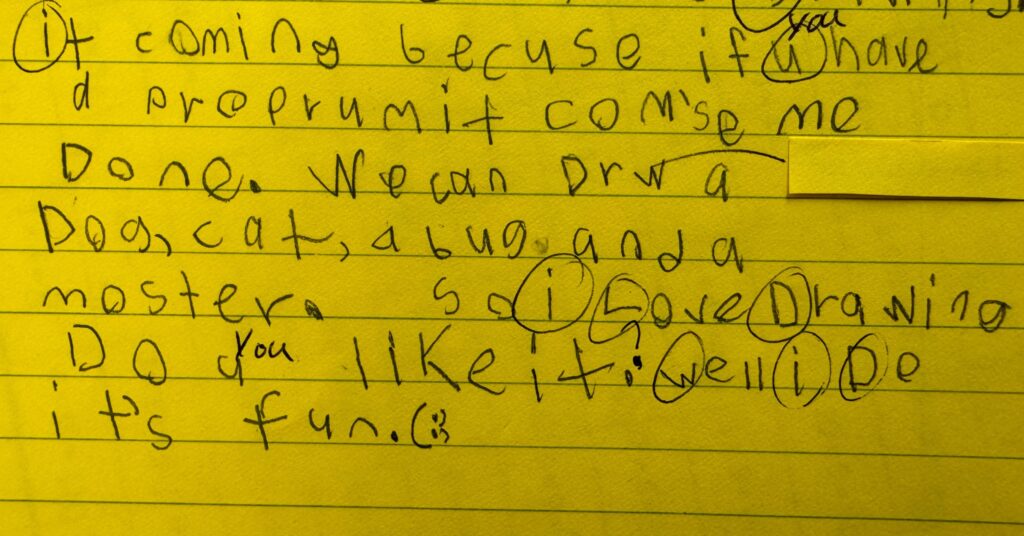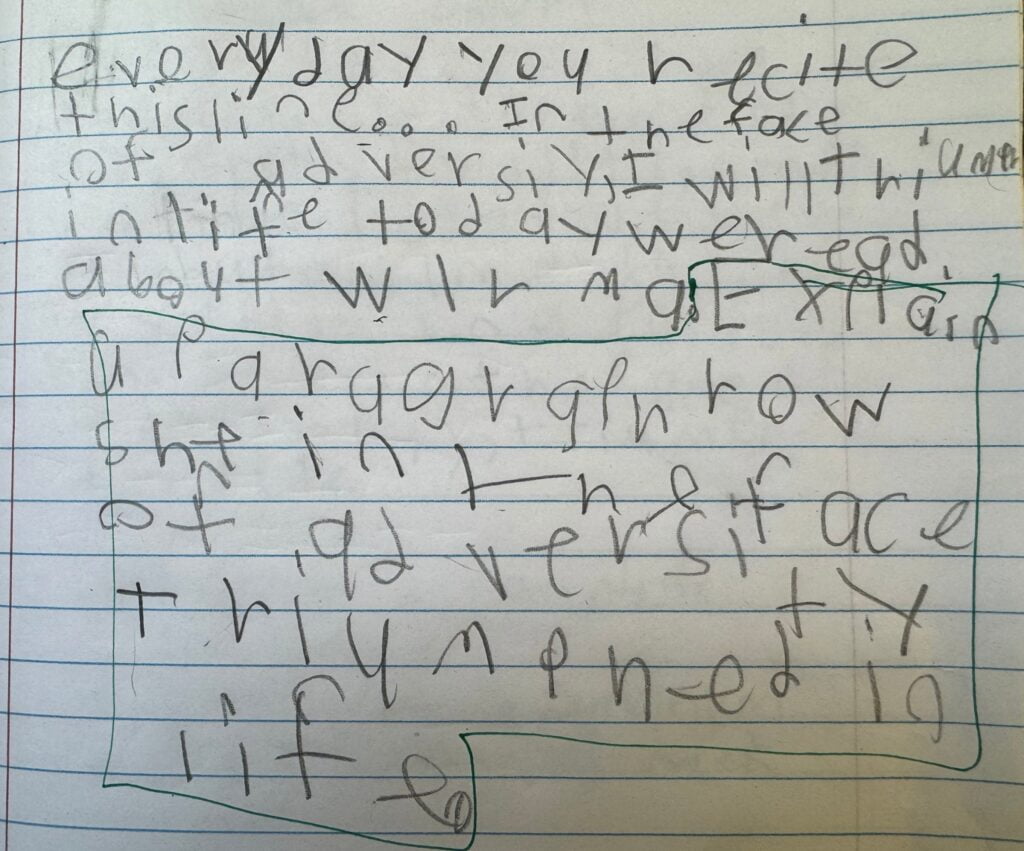Unlike dyslexia or lesser-known dyscalculia, dysgraphia is even less known. But its impact on learning and self-esteem is just as pronounced.
There are five types of dysgraphia- dyslexic, motor, spatial, phonological, and lexical. No matter the form, dysgraphia is a challenge many adults and kids face, which makes writing painfully hard. It is also referred to as a specific learning disorder in written expression.
According to IDS, dysgraphia is the condition of impaired letter writing. Impaired handwriting can interfere with learning to spell words in writing and the speed of writing text.
Children diagnosed with dysgraphia may exhibit challenges in either handwriting or spelling (with or without concurrent reading issues) or in both handwriting and spelling.
Having taught for over twenty years, the best way I can describe what dysgraphia looks like in a student is that they are writing with their non-dominant hand all the time.
This common learning disability makes handwriting look chaotic. It also complicates spelling, structuring ideas on paper, and dexterity.
What are the Five Types of Dysgraphia?
The five types of dysgraphia include the following:
- Dyslexic Dysgraphia
- Motor Dysgraphia
- Spatial Dysgraphia
- Phonological Dysgraphia
- Lexical Dysgraphia
It’s important to remember that dysgraphia is a brain-based, specific learning disorder. Many of the students I’ve taught have presented with more than one type of dysgraphia.
Dysgraphia affects approximately 7-15% of children, according to the NLM. Later in this article, I will show several examples of dysgraphia writing from my current students.
While many see it as a mere academic challenge, dysgraphia significantly impacts self-esteem and personal worth beyond the apparent academic hurdles.
A new study published in Neuroscience News found that handwriting, compared to typing, results in more complex brain connectivity patterns, which enhance learning and memory.
In a world where effective communication is paramount, the inability to express oneself proficiently in writing can create a sense of isolation. It can look different for different people.
Although I’ve never had a diagnosis, my handwriting has always been poor. I am very self-conscious about it.
I remember early in my teaching career, I wrote a hall pass for a student. When a hall monitor saw it, the monitor insisted that the student wrote it.
I stopped writing them after that. If this affected me this way, I can only imagine the toll this can take on a student’s self-esteem who faces this challenge daily.
As we talk about these types of dysgraphia, we’ll focus on three things:
- how someone writes without copying,
- how they write when copying, and
- how well they use their hands for smaller tasks.
According to occupational therapy (OT) professionals, who work closely with special education teachers and parents, these are the things they usually look at to figure out which type a student might have.
Dyslexic Dysgraphia: One of Five Types of Dysgraphia
When someone with this type writes on their own, it might be hard to read.
Surprisingly, when they copy something, it can look okay or even pretty good. Their spelling is often affected, meaning they are not good spellers.
The tricky part for them is coming up with how to form letters and shapes independently.
Interestingly, their speed and ability to use their hands for small tasks are usually normal.
Remember, even though dyslexia and dysgraphia are different things, they can co-exist.
Characteristics of Dyslexic Dysgraphia
- Poor spontaneous written work- writing that hasn’t been copied or traced.
- Copied work is okay- work that has been copied or traced has no issues.
- Minimal fine motor deficits- minimal issues with the ability to make precise, voluntary, and coordinated movements with hands.
Dyslexic dysgraphia example of writing:

Motor Dysgraphia: One of Five Types of Dysgraphia
Motor dysgraphia is a learning disorder where the individual’s writing skills are below the level expected for their age and cognitive level.
It is characterized by difficulty with fine motor skills and is the most common form of dysgraphia.
Moreover, it is more than just “poor handwriting.” It is a chronic, persistent, and significant long-term problem for children and adolescents.
Generally, it takes a lot of effort for the student to produce the writing. This is due to a deficit in fine motor skills.
They may have poor dexterity, poor muscle tone, or just unspecified motor clumsiness.
Motor dysgraphia often includes illegible handwriting, decreased writing speed, and discrepancies between oral and written output.
These students typically produce written work ranging from poor to illegible, impacting both spontaneous and copied tasks from another document.
While their letter formation may be acceptable in short writing samples, it’s evident that it requires significant effort and extra time.
Sustaining this level of letter formation or achieving “neat writing” over an extended period is a challenge for them.
Additionally, many of these students struggle with a poor grasp, resulting in crooked writing due to incorrect pen or pencil holding.
Issues such as excessive pressure, darker writing, or inconsistent pressure may arise from decreased fine motor skills.
Notably, their spelling abilities remain generally unaffected.
Characteristics of Motor Dysgraphia
- Poor fine motor skills
- Written work is illegible (spontaneous or copied)
- Short samples may be okay, with extra effort/time
- Poor grasp
- Spelling not affected
(In Figure 2, you can see that my little guy had a pretty poor grasp. Figure 2. Student with poor grasp.
And in the writing (see Figure 3), you can see that the pressure that he used to form those letters was very inconsistent.
Figure 3. Inconsistent pressure is demonstrated in this writing sample.
His fine motor skills were definitely delayed.)
Spatial Dysgraphia: One of Five Types of Dysgraphia
Spatial dysgraphia is usually due to a visual-spatial deficit. Visual-spatial issues deal with impairments in vision and perception skills.
These students have both illegible spontaneous written work and illegible copied work. Both types of writing are affected.
Typically, these students have normal spelling and fine motor skills, but they have trouble keeping their writing on the lines and difficulty with spacing between the words.
It can also be noted in their drawing skills as well.
Characteristics of Spatial Dysgraphia
- Visual-spatial deficit
- Both spontaneous and copied work are poor
- Spelling and fine motor skills are usually okay
- Poor baseline placement and spacing
Spatial Dysgraphia Example of Writing:

This student started out okay, as far as writing on the lines. However, as he continued, you can see the baseline placement of his letters was impacted.
Phonological Dysgraphia
Phonological dysgraphia is language-based. It has to do with difficulty spelling words, especially non-words.
These students struggle with retaining phonemes in memory and correctly blending them in the appropriate sequence to spell words.
Individuals with phonological dysgraphia often struggle with poor spelling and messy, disorganized writing when they’re writing on the spot.
However, copying existing texts is usually less challenging for them.
Despite having normal motor control skills, dyslexic dysgraphia reflects a gap between forming thoughts and translating them into writing.
People with this form of dysgraphia might mix up uppercase and lowercase letters, leave words incomplete, or produce handwriting that’s hard to read.
Characteristics of Phonological Dysgraphia
- Notable in the spelling of unfamiliar words, non-words, and phonetically irregular words
- Difficulty with phonemes and blending appropriately
Lexical Dysgraphia
Lastly, lexical dysgraphia is a type of dysgraphia that makes it hard to write words either letter by letter or by visualizing them.
When someone has Lexical Dysgraphia, they can spell, but they tend to rely on regular sound-to-letter patterns. They often misspell irregular words.
This happens more often in languages like English and French, which aren’t as straightforward in their phonetic sounds as, say, Spanish.
It’s worth noting that this type of Dysgraphia is quite uncommon in kids but is seen in adults with traumatic brain injuries.
Characteristics of Lexical Dysgraphia
- Relies on sound-to-letter patterns
- Misspellings in irregular word
Signs and Symptoms of Dysgraphia
Handwriting Challenges
Dysgraphia makes writing a tricky puzzle, where letters mix up, words spread out awkwardly, and sentences wander.
Kids with this condition seem like they’re wrestling with their pencils, trying hard to form letters that either clump together or stretch too far.
Organizing text isn’t any simpler; they might start writing in the middle of the page or forget about margins. It’s tiring.
Some students manage neatness, but it takes a lot of effort, which isn’t efficient or sustainable for longer writing tasks.
Beyond Handwriting
Most understand that dysgraphia impacts handwriting, however, it impacts more than just handwriting. The following are other areas impacted:
Writing Mechanics
Dysgraphia may lead to issues with spelling, grammar, punctuation, and sentence structure.
Organizing Thoughts
Dysgraphia can hinder the ability to organize writing coherently, even when ideas are strong.
Executive Functioning
Dysgraphia may create challenges in executive functions like planning and organizing.
Writing Process
Dysgraphia can slow down the writing process, causing frustration and impacting the ability to express oneself effectively in writing.
Unfortunately, more kids deal with this issue than most people are aware of.
Causes and Associated Conditions of Dysgraphia
Neurological
When we look at how the brain works, we discover that dysgraphia goes beyond messy handwriting. It’s connected to the neurological workings of our brains.
It’s believed to arise from neurological differences that make it tough for kids to express their thoughts in writing.
While scientists haven’t singled out one cause, they link it to areas in the brain responsible for language and fine motor skills.
This sheds light on why some kids struggle to hold a pencil, feeling like they’re attempting to climb a mountain without the right gear.
The exciting part, however, is that with the proper support, kids can overcome these challenges.
To understand more about how our brains impact learning disabilities like dysgraphia, this study on neurobiological aspects of dyslexia offers insights that are also relevant for understanding dysgraphia due to overlapping neurological pathways.
Dysgraphia and Other Conditions
Students with ADHD (Attention Deficit Hyperactivity Disorder), or ASD (Autism Spectrum Disorder) often find themselves navigating the choppy waters of writing difficulties alongside other challenges.
The overlap isn’t coincidental but indicates shared neural highways between these conditions and writing disorders like dysgraphia.
In fact, studies show a higher prevalence among students who already juggle attention or social interaction hurdles.
This mingling underscores the significance of crafting personalized approaches that honor the distinct characteristics of each learner.
It ensures that, with the right adjustments, every student can soar.
Gender Disparity in Dysgraphia Cases
Historically, gender disparity isn’t uncommon in the world of common learning disabilities.
Many studies support the fact that boys are diagnosed with dysgraphia more frequently than girls. This goes for other common learning disabilities too.
The disparity in dysgraphia diagnoses between boys and girls isn’t a minor issue; it’s substantial enough that both educators and parents should take note.
The reasons behind this disparity aren’t entirely clear but could involve various factors such as differences in brain development, societal expectations of behavior, or even the way symptoms manifest across genders.
What’s certain is that understanding this disparity can help tailor more effective support strategies for all children struggling with dysgraphia.
Resources like the National Center for Learning Disabilities can shed light on the nuances of dysgraphia’s prevalence among children, particularly its disproportionate impact on boys compared to girls.
Such platforms offer valuable information not only on prevalence rates but also on intervention strategies that cater specifically to the needs of students facing these challenges.
Five Types of Dysgraphia Impacting Written Expression
We’ve looked deep into understanding dysgraphia in kids. We realize it’s more than just messy handwriting. A person can struggle with spelling and getting their thoughts organized.
Lots of kids deal with dysgraphia, but with the right help, like some changes in the classroom and occupational therapy, things can get much better.
Here’s a crucial thing to remember: dysgraphia doesn’t mean a lack of smarts. These kids are bright; they just show it in their own special way.
To sum it up, understanding what dysgraphia is about in kids is the first step to giving them the support they need for success.
Always remember: Every child has potential, no matter how they write.

0 Comments